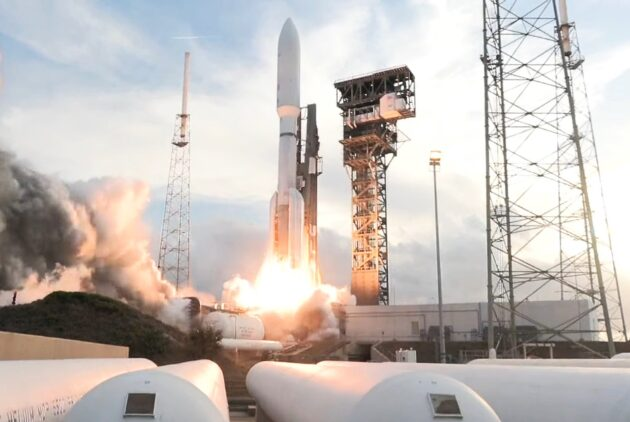Flawless launch for 1st Project Kuiper satellite batch
April 29, 2025
By Chris Forrester

United Launch Alliance (ULA) placed a batch of Amazon’s Project Kuiper satellites into orbit at 7.01pm Florida time on April 28th. The undisclosed number of broadband satellites will eventually challenge SpaceX’s Starlink system. The KA-01 launch took place from Cape Canaveral.
Starlink and now Project Kuiper are both part of an effort to transform global Internet infrastructure. The network’s aim is to provide access to remote corners of the world where traditional broadband, which relies on underground cables, is lacking. ULA said all of the satellites were deployed successfully.
Unusually, the ULA video of the launch was suspended prior to the satellites deployment, and thus ensuring that the precise number of craft on board remained private. The shut-down of the video feed is a level of secrecy normally reserved for national security missions, not commercial broadband satellites.
The ULA Atlas V rocket launched this first cluster of satellites, part of an eventual target of 3,276 craft, which will circle the planet. The Kuiper 1 mission is the first of 46 launches by ULA for the Kuiper constellation using eight Atlas V versions and 38 of the more powerful Vulcan rockets.
This launch is at least one year behind the original plan and is pressing because Project Kuiper must have at least 50 per cent of its 3,200 craft fleet in orbit by July 2026.
But while the Kuiper much-delayed launch is welcome, the Jeff Bezos-backed system has a long way to go to even begin to attack Starlink’s domination of the market. Starlink, as if to rub salt into the Kuiper problems, gleefully reminded observers that it launched two batches of its Starlink craft in the same 24-hour period, and confirmed that one of them was its 250th successful launch of its own SpaceX Falcon 9 rocket.
Starlink’s second launch (at 10.09pm Florida time on April 27th) placed 23 satellites into orbit, of which 13 were its ‘direct-to-cellular’ versions. Starlink holds a huge lead in the race to provide high-speed, low-latency Internet access from low Earth orbit. SpaceX currently has more than 7,000 Starlink satellites in orbit, serving more than 5 million customers. Still more satellites are being produced every month at SpaceX’s development and manufacturing facility in Redmond, not far from Project Kuiper’s headquarters.
Starlink has shown it can profitably handle relationships with consumers in hundreds of countries around the world. But Amazon already has extensive relationships with customers and viewers to its Prime Video streaming service. Amazon CEO Andy Jassy has said Project Kuiper is a “very large revenue opportunity for Amazon” — and could become a “fourth pillar” supporting the company’s overall business model. Some analysts say the Kuiper effort may end up costing as much as $20 billion.
“Kuiper is going to have a long way to go to catch up to be able to serve a significant part of the market,” Craig Moffett, senior managing director at the research firm MoffettNathanson, told CNN. “It looks like there is a very, very high probability that this will turn out to be too late for it to ever come close to being an attractive investment.”
Eric Burger, an observer of the satellite and launch industry, said: “It is incredible that SpaceX reached this milestone in less than six years. (The first dedicated Starlink launch occurred on May 24th, 2019.) Everyone in the space community takes it for granted, but the Falcon 9 is an amazing rocket.”
Other posts by :
- Russian satellite tumbling out of control
- FCC boss praises AST SpaceMobile
- Rakuten makes historic satellite video call
- Rocket Lab confirms D2C ambitions
- Turkey establishes satellite production ecosystem
- Italy joins Germany in IRIS2 alternate thoughts
- Kazakhstan to create museum at Yuri Gagarin launch site
- AST SpaceMobile gets $42 or $1500 price target
- Analyst: GEO bloodbath taking place
